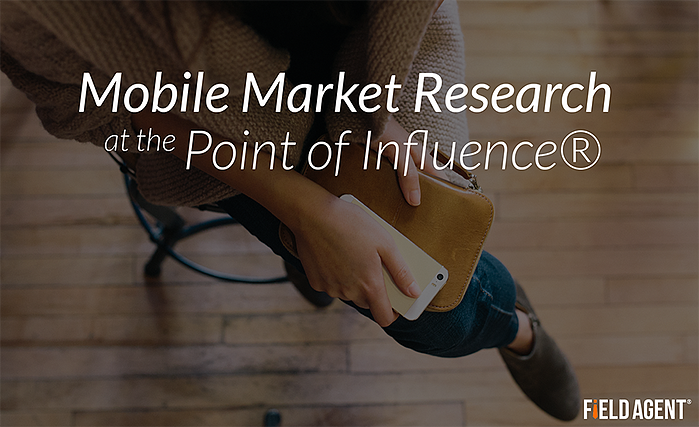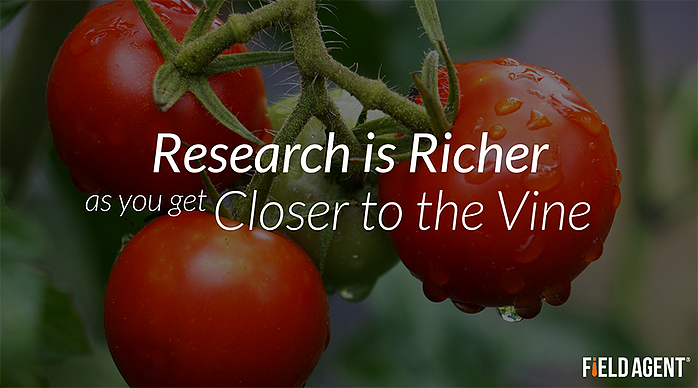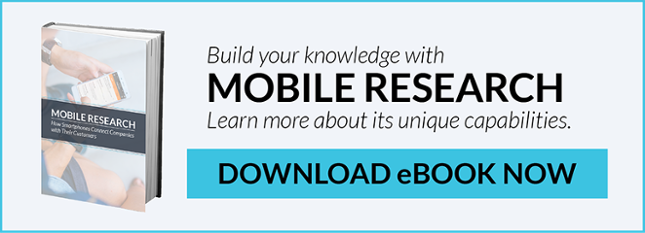
When conducting research, how do you find out how someone is thinking versus what they thought? Time and distance are the two things that keep us from getting closer to what's presently happening. However, with mobile market research, we can get closer with real-time data. This post was extracted from a presentation at the 2014 IIeX (Insight & Innovation Exchange) Conference and will help you understand how Mobile Research allows you to capture insights from consumers via qualitative methodologies that were not possible a few years ago.
Getting Closer to the Vine
Let's talk about something is near and dear to everyone's heart today, which is food. Caprese, right? Capresing up. Capris, I was trying to practice it all day long. My wife and I were out for dinner a few weeks ago, and that's the appetizer that we ordered. There are really only four key elements in that appetizer, right? The first one is fresh mozzarella. The second is tomatoes. The third, balsamic. And the fourth is basil. Four key ingredients.
Now what is the one element that you think that makes or breaks that dish? If something's not fresh, what do you think is going to make the whole thing go bad? The tomatoes. I want you to think about that dish and how it relates to research.
Time and Distance
This is the tip we're going to give you for today. The first thing is that time and distance is really what drives us away from being closer to the vine. My wife's a dietitian, she said, “Rick it's easy, if you want to be healthier eat closer to the vine.”
It would be much better if we could go to the actual farm and pull the tomato right off the vine. It would be as fresh as fresh could be. Time and distance keeps us from getting close to the vine.
Think about that practically. I went to Publix today and I picked up a tomato. It looks pretty good to me. But we all know intuitively, because we've been preached that vegetables at the farmer’s market are better.
I really don't know what Publix did to this, probably nothing. But it’d be so much better from a farmer’s market – it’d have more nutrition and probably lower calories – because it would be a little bit closer. But, there's nothing wrong with buying something from a Publix supermarket.
The next piece is, well what about just packaging. This is the packaging. They were side by side. It's the exact same tomato. One happens to be packaged with two versus one. But we would probably choose the one by itself. It just feels like it's healthier. What about the can of tomatoes? It's the same tomato in theory. We would all rather be closer to the vine.
Practically speaking for us, this is a really important analogy. The only thing that keeps us from having our own garden and being able to pull something off a vine is time and distance.
Think vs. Thought
Let's play that out from a research standpoint. In order to get closer to the vine, that means you're actually going to get closer to how someone's thinking versus what they thought. The only key thing that keeps any of us from getting really close to the vine in a research standpoint is time and distance. If you had the time to do 500 individual interviews inside of someone's home and literally watch everything that they did, maybe we would give that a shot. But time and distance is a problem.
Traditional Research Methodology
Believe it or not traditional methodology has launched billion dollar brands. But we still have the problem of time and distance in traditional research methodologies. Now with the innovation in technology, we’re able to do just that. Mobile technology has allowed us to get closer to what people are actually thinking.
It’s important for researchers to realize that if you don't have some sort of mobile or technology aspect into research, you’re missing out.
See also: Are you Following the Golden Rule of Market Research Technology?

Point of Influence - Zero, First, and Second Moments of Truth
Sure you can use mobile but it doesn't really get us as hot as we want. Let's talk about how we really address this in three key moments of mobile technology, as we're getting closer to the vine - engagement at the point of influence.
We talk a lot about that first moment of truth. The first moment where we're actually at the shelf and we make a purchase. Everyone intuitively says yes I understand how mobile technology or smart devices help me understand that first moment of truth.
We started to find out that the zero and second moment of truth is also very important to understand. The second moment of truth is consumption or using a service. IHUTS (In-Home Usage Tests) are really interesting when you use mobile technology to enhance the IHUT experience out of someone's home – whether they're using diapers, consuming foods, or using something that is out of someone's garage. But what's more important is that zero moment of truth.
Time and time again we hear people talk about scraping the web and big data. Mobile research and smart devices also play a role in the zero moment of truth, especially when you look at diary studies. It's important to understand the zero moment of truth. What are you doing prior to making a purchase? Are you online? Are you talking to friends? Are you looking at Amazon’s five star ratings? Mobile research allows you to capture that as well.
iBeacon Buzz
When you think of those three key things from a technology standpoint and that we all want to get really close to the vine, we think about the latest buzz called the iBeacon.
Everyone's saying, "forget about this whole issue of geo-fencing, forget about technology it's all about this iBeacon. It's the latest rage." We're going to unpack that a little bit and understand it from a researchers perspective.
The first piece is, when you think about location it's really important to understand three facets to how to conduct research from a location-based perspective. The first one is good old-fashioned process. We have been doing research based on locations for decades. Again, you've built billion-dollar brands through traditional methodologies and getting inside of peoples homes and inside of stores. Geo-fencing allows us to understand when someone walks into a store, when they leave their home, or when they're within 20 feet of this, or 10 feet of that.
From a research perspective, understanding that almost every type of location-based research you want to do can be enabled by work processes. I can pay you before you do something. I can ask you to do a mobile diary study at night. I can do a push notification. Geo-fencing allows us to track when you go in and out of circles. It can tell us if that's your home on the left and that's the retailer on the right and when you go in and out of a circle.
If you have the Find my iPhone app, you would see you've got a circle around you of about 250 feet. If you are researcher and you need information from Starbucks – 250 feet around that location, means you might be three stores down when you actually get pinged.
As researchers we have to be smart enough to understand that technology doesn't solve everything for us. Then someone says, "Aw that's okay. We're going to do this iBeacon thing. It's fantastic. The iBeacons are going to get less than within six inches of where you are. It's going to capture all this data. It's going to solve all of our problems."
You’ll see in the presentation pictures of iBeacons. They're just little apparatuses. It operates pretty much the same way Bluetooth works in newer cars. You're happy within a certain location, your phone connects and everything is great. When you leave that location, it disconnects.
GE uses iBeacon, so it’s got to be good, right?
These past two weeks ago, GE came out and said, "Don't worry about all those little iBeacons, we're going to put iBeacon technology inside of lights." They announced it two weeks ago. They're in partnership with Walmart and they're going to put technology in all the light fixtures. Can’t you just see it now? You're excited already. That way we can track everywhere you go and everything you do and we're going to ping your phone. It's going to be fantastic.
As a researcher, you look at that and say is that really what I'm looking for? Let's play this out a little bit. You’ll see in the presentation a visual of a Walmart Supercenter with 50 iBeacons. Imagine if you had just 50 iBeacons at a Walmart store and we only allowed the top three suppliers of those categories to ping you and say, you want an ad? You want a coupon? You want a survey? You want an ad? You want a survey? You want a coupon? Only 50.
What if we had 100 of those? What if you only had a 100 of those in light fixtures? It would solve all our problems. As researchers we know it's great. I now know everywhere you are in the store and we're going to solve all our research problems because we've got it all figured it out, right?
Think about the practical part of this. How long does someone normally stand in front of a shelf? It takes three to five seconds on a good day for the iBeacon to even connect to your phone. If I'm pushing my cart iBeacon hits, one thousand one, one thousand two, one thousand three, I've left the shaving aisle and now I'm in the shampoo aisle.
Meanwhile, if you get pinged every other minute, what are you going to do with your phone? You're going to turn it off. The location is going to go off. If you don't turn it off, what's it going to do to your battery? But this is going to solve all of our problems, right? It's going to solve all of our problems. Just like the iPhone is going to solve all of our problems. I guarantee you Google Glasses are going to solve all your problems.
Remember if you've been in research any longer than five years, you were launching billion dollar brands without technology. We need to understand that there are three key opportunities everyone here has to understand about mobile, specifically around consumers you're engaging because remember the two guys in the basement, or you're high-school students, or friends down the street can create an App for you today.
What to Understand with Mobile Research
1. Trust in data
For years, people really question online surveys and how do I know some guy in India didn't have a warehouse and was doing this. How do I know that they didn't straight-line it? Oh, don't worry I have algorithms built in and you have your favorite panels and you are ensured of quality data.
You have to ask the same question of your data provider when it comes to mobile technology. What are your algorithms? What steps do you have in place? How do you perform QC? Do you look at every photo? Do you really understand who's taking this survey? How do you know if they're not 13 years old versus 18 year olds when they sent that picture? Therefore there's a problem. These are all the questions you have to ask because you can't chase a shiny object.
2. Location variables
Some people think – I have great technology, I can do this and do that. It doesn't matter if they don't understand how shoppers work. They understand how people engage with the phones. But, think about this as customers are shopping – data has shown that roughly 80% percent of people going into geo-fencing will react to a push notification.Women in the room you probably have your hand on your phone. You're engaging walking in. Guys same thing. When guys leave a store, what do they have in their hands because they don't use a cart? Two bags. Guys don't use carts. But women when you leave the store, where's your phone? Less than 30% of the people who leave a Geo-fenced location is going to react because your phone is in the wrong location. That's really important to know if you're trying to get 200 completes outside of a Starbucks, Publix, or Walmart. You have to understand there are all these variables from a location standpoint. It doesn't matter how cool your shiny object is or how cool the technology is, if you don't understand that you're going to get bad data.
3. Verification
The final piece is hackers. There's nothing like a hacker convention where people are trying to figure out how they can bust through someone's App. My favorite one is the GPS Spoof. It's a fantastic App – I would never use it.
Let's say for example that I'm on my way home. I call my wife. I say, “Hun I'm going to go to Buffalo Wild Wings tonight with a couple of guys from work. I'll catch you later.” I'm just Tweeting, posting a couple of photos and sending stuff back and forth from Buffalo Wild Wings. But really I'm playing golf because I downloaded GPS Spoof and I have Spoof to say that I'm there.
That's my reality. There are people out there that are hacking; they've jail-broken their phones. They can say that they're anywhere they want to be so that type of understanding is really important. You have to decide as a researcher, are you going to accept data from the jail-broken phone? Maybe, but you shouldn't.
If he's into sports, do you care? If you're looking for a 35 to 45 year old women to buy certain cosmetics, do you really think she has a jail-broken phone? These are great questions that you have to ask. Here's where you have to focus on and think about from left to right. At Field Agent we strive and take pride in our Quality Control process from how we verify each piece of data to how we work with clients.
What’s the solution - Mobile Technology
Either you identify or your client identifies problems. You want to get those to objectives. Then you have to design methodology, you have to go execute it, whether it's a specific group of people, I won’t say focus group because you guys will yell at me because I'm so old. You want to do an online survey, you want to do a mobile panel, or you have to make sure they verify the data and then you write a report. What's important for you today is as you walk around these aisles and start looking at technology and how you're going to implement this, you have to make sure that you've got someone who understands how to design the methodology with mobile in mind.
In our case, we have researchers on staff who are engaged in your research and understands what you’re looking for. Often cases, you're going to integrate that back in. Then, you think of verification. We actually have folks that have eyes on every piece of data that comes in. We look at every single photo, and we've read every single piece of data, we understand the algorithms associated with it, because what are you going to do with a thousand photos that aren't any good.
Quality Control
How are you really going to crank through two or three thousand, two-minute videos? How are you going to know if they're right or not? How are you really going to integrate your five years worth of data doing online surveys and trying to figure out how to match it up with mobile technology, because it's important that you have that aspect in what you're doing? Think about those things as you're going down that path.
The next piece for you, that I’m going to leave you with is that from a mobile standpoint it is really important to understand that your client is going to be ask questions like “How are you using mobile?” or “What is your mobile alternative?”
If you're an agency know that all of the other agencies left or right of you are going to be talking about that as well and you don't want to be behind. At the same time, there's nothing out there that any of us can do when you're competing head to head and the person has 20 years experience AND they also have mobile technology as well. That's where most of us need to play.
Playing in the Mobile Research World
Whether you are qualitative researcher, a consultant on your own or a full-fledged agency and you are full service, you have to have an alternative for that and you need a partner to come along side. Call one of our experts OR start your project today on our Do-It-Yourself platform.
See how we used Mobile Research to learn more about a very specific group of people - Millennials who are cutting the cord.



